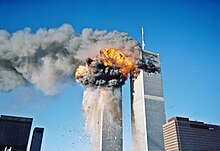
Back اختطاف الطائرات Arabic Aviaquldurluq Azerbaijani Segrest aeri Catalan Únos letadla Czech Flykapring Danish Flugzeugentführung German Αεροπειρατεία Greek Piratería aérea Spanish Õhupiraatlus Estonian هواپیماربایی Persian


| Part of a series on |
| Terrorism and political violence |
|---|
Aircraft hijacking (also known as airplane hijacking, skyjacking, plane hijacking, plane jacking, air robbery, air piracy, or aircraft piracy, with the last term used within the special aircraft jurisdiction of the United States) is the unlawful seizure of an aircraft by an individual or a group.[1] Dating from the earliest of hijackings, most cases involve the pilot being forced to fly according to the hijacker's demands. There have also been incidents where the hijackers have overpowered the flight crew, made unauthorized entry into the cockpit and flown them into buildings—most notably in the September 11 attacks—and in some cases, planes have been hijacked by the official pilot or co-pilot, such as with Ethiopian Airlines Flight 702.[2][3][4][5]
Unlike carjacking or sea piracy, an aircraft hijacking is not usually committed for robbery or theft. Individuals driven by personal gain often divert planes to destinations where they are not planning to go themselves.[6] Some hijackers intend to use passengers or crew as hostages, either for monetary ransom or for some political or administrative concession by authorities. Various motives have driven such occurrences, such as demanding the release of certain high-profile individuals or for the right of political asylum (notably Ethiopian Airlines Flight 961), but sometimes a hijacking may have been affected by a failed private life or financial distress, as in the case of Aarno Lamminparras in Finnair Flight 405.[7] Hijackings involving hostages have produced violent confrontations between hijackers and the authorities, during negotiation and settlement. In several cases – most famously Air France Flight 139, Lufthansa Flight 181, and Air France Flight 8969 – the hijackers were not satisfied and showed no inclination to surrender, resulting in the deployment of counterterrorist police tactical units or special forces to rescue the passengers.[8]
In most jurisdictions of the world, aircraft hijacking is punishable by life imprisonment or a long prison sentence. In most jurisdictions where the death penalty is a legal punishment, aircraft hijacking is a capital crime, including in China, India, Liberia, and the U.S. states of Georgia and Mississippi.
- ^ "49 U.S. Code § 46502 – Aircraft piracy". LII / Legal Information Institute. Archived from the original on 2015-11-16. Retrieved 2015-12-06.
- ^ "Swiss confirm Ethiopian plane hijack". 17 February 2014. Archived from the original on 18 February 2014. Retrieved 17 February 2014.
- ^ "Photos: Major aircraft hijackings that shocked the world". Mid-Day. Archived from the original on 24 December 2014. Retrieved 24 December 2014.
- ^ "Air China pilot hijacks his own jet to Taiwan". CNN. 28 October 1998. Archived from the original on 21 March 2008. Retrieved 25 January 2007.
- ^ B. Raman (2 January 2000). "Plane Hijacking in Perspective". South Asia Analysis Group. Archived from the original on 2 April 2015. Retrieved 29 January 2015.
- ^ Nelson, Libby (2016-03-29). "The US once had more than 130 hijackings in 4 years. Here's why they finally stopped". Vox. Archived from the original on 2019-06-29. Retrieved 2019-06-29.
- ^ Lauri Puintila (2010). Kaappari Lamminparras: Suomen ensimmäisen konekaappauksen tarina (in Finnish). WSOY. ISBN 978-951-0-35501-5.
- ^ "History of airliner hijackings". 2001-10-03. Archived from the original on 2019-06-28. Retrieved 2019-06-29.